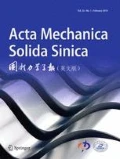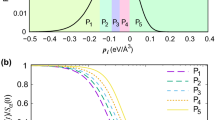Abstract
The properties of the confined liquid are dramatically different from those of the bulk state, which were reviewed in the present work. We performed large-scale molecular dynamics simulations and full-atom nonequilibrium molecular dynamics simulations to investigate the shear response of the confined simple liquid as well as the n-hexadecane ultrathin films. The shear viscosity of the confined simple liquid increases with the decrease of the film thickness. Apart from the well-known ordered structure, the confined n-hexadecane exhibited a transition from 7 layers to 6 in our simulations while undergoing an increasing shear velocity. Various slip regimes of the confined n-hexadecane were obtained. Viscosity coefficients of individual layers were examined and the results revealed that the local viscosity coefficient varies with the distance from the wall. The individual n-hexadecane layers showed the shear-thinning behaviors which can be correlated with the occurrence of the slip. This study aimed at elucidating the detailed shear response of the confined liquid and may be used in the design and application of micro- and nano-devices.
Similar content being viewed by others
References
White, F.M., Fluid Mechanics. New York: McGraw-Hill, 1994.
Granick, S., Motions and relaxations of confined liquids. Science, 1991, 253: 1374–1379.
Horn, R.G. and Israelachvili, J.N., Direct measurement of structural forces between two surfaces in a non-polar liquid. Journal of Chemical Physics, 1981, 75: 1400–1411.
Heuberger, H., Zach, M. and Spencer, N.D., Density fluctuations under confinement: when is a fluid not a fluid? Science, 2001, 292: 905–908.
Gee, M.L., McGuiggan, P.M., Israelachvilil, J.N. and Homola, A.M., Liquid to solidlike transitions of molecularly thin films under shear. Journal of Chemical Physics, 1990, 93: 1895–1906.
Zhu, Y.X. and Granick, S., Superlubricity: a paradox about confined fluids resolved. Physical Review Letters, 2004, 93: 096101.
Bhushan, B., Israelachvili, J.N. and Landman, U., Nanotribology: friction, wear and lubrication at the atomic scale. Nature, 1995, 374: 607–616.
Demirel, A.L. and Granick, S., Origins of solidification when a simple molecular fluid is confined between two plates. Journal of Chemical Physics, 2001, 115: 1498–1512.
Mukhopadhyay, A., Bae, S.C., Zhao, J. and Granick, S., How confined lubricants diffuse during shear. Physical Review Letters, 2004, 93: 236105.
Karniadakis, G., Beskok, A. and Aluru, N., Microflows and Nanoflows: Fundamentals and Simulation. New York: Springer, 2005.
Yuan, Q.Z. and Zhao, Y.P., Hydroelectric voltage generation based on water-filled single-walled carbon nanotubes. Journal of the American Chemical Society, 2009, 131: 6374–6376.
Qin, X.C., Yuan, Q.Z., Zhao, Y.P., Xie, S.B. and Liu, Z.F., Measurement of the rate of water translocation through carbon nanotubes. Nano Letters, 2011, dx.doi.org/10.1021/nl200843g.
McGuiggan, P.M., Gee, M.L., Yoshizawa, H., Hirz, S.J. and Israelachvili, J.N., Friction studies of polymer lubricated surfaces. Macromolecules, 2007, 40(6): 2126–2133.
Lim, R., Li, S.F.Y. and O’Shea, S.J., Solvation forces using sample-modulation atomic force microscopy. Langmuir, 2002, 18: 6116–1624.
Patil, S., Mater, G., Oral, A. and Hoffmann, P.M., Solid or liquid? solidification of a nanoconfined liquid under nonequilibrium conditions. Langmuir, 2006, 22: 6485–6488.
Cui, S.T., Gupta, S.A., Cummings, P.T. and Cochran, H.D., Molecular dynamics simulations of the rheology of normal decane, hexadecane, and tetracosane. Journal of Chemical Physics, 1996, 105: 1214–1220.
Gao, J.P., Luedtke, W.D. and Landman, U., Origins of solvation forces in confined films. Journal of Physical Chemistry B, 1997, 101: 4013–4023.
Israelachvili, J.N., Intermolecular and Surface Forces. San Diego: Academic Press, 1992.
Yin, J. and Zhao, Y.P., Hybrid QM/MM simulation of the hydration phenomena of dipalmitoylphosphatidylcholine headgroup. Journal of Colloid and Interface Science, 2009, 329: 410–415.
Yang, C.Y. and Zhao, Y.P., Influences of hydration force and elastic strain energy on stability of solid film in very thin solid-on-liquid structure. Journal of Chemical Physics, 2004, 120: 5366–5376.
Yamada, S., Layering transitions and tribology of molecularly thin films of poly(dimethylsiloxane). Langmuir, 2003, 19: 7399–7405.
Jabbarzadeh, A., Harrowell, P. and Tanner, R.I., Very low friction state of a dodecane film confined between mica surfaces. Physical Review Letters, 2005, 94: 126103.
Jabbarzadeh, A., Harrowell, P. and Tanner, R.I., Crystal bridge formation marks the transition to rigidity in a thin lubrication film. Physical Review Letters, 2006, 96: 206102.
Bureau, L., Rate effects on layering of a confined linear alkane. Physical Review Letters, 2007, 99: 225503.
Cui, S.T., McCabe, C., Cummings, P.T. and Cochran, H.D., Molecular dynamics study of the nano-rheology of n-dodecane confined between planar surfaces. Journal of Chemical Physics, 2003, 118: 8941–8944.
Reiner, M., The Deborah number. Physics Today, 1964, 17: 62.
Landau, L.D. and Lifshitz, E.M., Theory of Elasticity. Oxford: Butterworth-Heinemann, 1999.
Kumacheva, E. and Klein, J., Simple liquids confined to molecularly thin layers. II. Shear and frictional behavior of solidified films. Journal of Chemical Physics, 1998, 108: 7010–7022.
Khan, S.H., Matei, G., Patil, S. and Hoffmann, P.M., Dynamic solidification in nanoconfined water films. Physical Review Letters, 2010, 105: 106101.
Bureau, L., Nonlinear rheology of a nanoconfined simple fluid. Physical Review Letters, 2010, 104: 218302.
Granick, S., Bae, S.C., Kumar, S. and Yu, C., Confined liquid controversies near closure? Physics, 2010, 3: 73.
Huang, D.M., Sendner, C., Horinek, D., Netz, R.R. and Bocquet, L., Water slippage versus contact angle: a quasiuniversal relationship. Physical Review Letters, 2008, 101: 226101.
Granick, S., Lee, H. and Zhu, Y., Slippery questions of stick when fluid flows past surfaces. Nature Materials, 2003, 2: 221–227.
De Gennes, P.G., On fluid/wall slippage. Langmuir, 2002, 18: 3413–3414.
Thompson, P.A. and Troian, S.M., A general boundary condition for liquid flow at solid surfaces. Nature, 1997, 389: 360–362.
Lauga, E., Apparent slip due to the motion of suspended particles in flows of electrolyte solutions. Langmuir, 2004, 20: 8924–8930.
Schmatko, T., Hervet, H. and Leger, L., Friction and slip at simple fluid-solid interfaces: the roles of the molecular shape and the solid-liquid interaction. Physical Review Letters, 2005, 94: 244501.
Vinogradova, O.I., Slippage of water over hydrophobic surfaces. International Journal of Mineral Processing, 1999, 56: 31–60.
Jabbarzadeh, A., Atkinson, J.D. and Tanner, R.I., Wall slip in the molecular dynamics simulation of thin films of hexadecane. Journal of Chemical Physics, 1999, 110: 2612–2620.
Jabbarzadeh, A., Atkinson, J.D. and Tanner, R.I., Effect of the wall roughness on slip and rheological properties of hexadecane in molecular dynamics simulation of Couette shear flow between two sinusoidal walls. Physical Review E, 2000, 61: 690–699.
Pit, R., Hervet, H. and Leger, L., Direct experimental evidence of slip in hexadecane: solid interfaces. Physical Review Letters, 2000, 85: 980–983.
Zhu, Y.X. and Granick, S., Rate-dependent slip of Newtonian liquid at smooth surfaces. Physical Review Letters, 2001, 87: 096105.
Plimpton, S., Fast parallel algorithms for short-range molecular-dynamics. Journal of Computational Physics, 1995, 117: 1–19.
Berendsen, H.J.C., Grigera, J.R. and Straatsma, T.P., The missing term in effective pair potentials. Journal of Physical Chemistry, 1987, 91: 6269–6271.
Hoover, W.G., Canonical dynamics: equilibrium phase-space distributions. Physical Review A, 1985, 31: 1695–1697.
Stuart, S.J., Tutein, A.B. and Harrison, J.A., A reactive potential for hydrocarbons with intermolecular interactions. Journal of Chemical Physics, 2000, 112: 6472–6486.
Halicioglu, T. and Pound, G.M., Calculation of potential energy parameters from crystalline state properties. Physica Status Solidi A: Applied Research, 1975, 30: 619–623.
Dauberosguthorpe, P., Roberts, V.A., Osguthorpe, D.J., Wolff, J., Genest, M. and Hagler, A.T., Structure and energetics of ligand binding to proteins: escherichia coli dihydrofolate reductase-trimethoprim, a drug-receptor system. Proteins-Structure Function and Genetics, 1988, 4: 31–47.
Ardekani, A.M. and Joseph, D.D., Instability of stationary liquid sheets. Proceedings of the National Academy of Sciences of the United States of America, 2009, 106: 4992–4996.
De Gennes, P.G., Brochard-Wyart, F. and Quere, D., Capillarity and Wetting Phenomena. New York: Springer, 2004.
Brochard-Wyart, F., Raphael, E. and Vovelle, L., Démouillage en régime inertiel: apparitions d’ondes capillaries. Comptes Rendus de l’Académie des Sciences, 1995, 321: 367–370.
Wang, F.C., Feng, J.T. and Zhao, Y.P., The head-on colliding process of binary liquid droplets at low velocity: High-speed photography experiments and modeling. Journal of Colloid and Interface Science, 2008, 326: 196–200.
Yuan, Q.Z. and Zhao, Y.P., Precursor film in dynamic wetting, electrowetting and electro-elasto-capillarity. Physical Review Letters, 2010, 104: 246101.
Li, J., AtomEye: an efficient atomistic configuration viewer. Modelling and Simulation in Materials Science and Engineering, 2003, 11: 173–177.
Jabbarzadeh, A. and Tanner, R.I., Crystallization of alkanes under quiescent and shearing conditions. Journal of Non-Newtonian Fluid Mechanics, 2009, 160: 11–21.
Drummond, C., Alcantar, N. and Israelachvili, J., Shear alignment of confined hydrocarbon liquid films. Physical Review E, 2002, 66: 011705.
Martini, A., Roxin, A., Snurr, R.Q., Wang, Q. and Lichter, S., Molecular mechanisms of liquid slip. Journal of Fluid Mechanics, 2008, 600: 257–269.
Doi, M. and Edwards, S.F., The Theory of Polymer Dynamics. Oxford: Calderon Press, 1986.
Yin, J., Zhao, Y.P. and Zhu, R.Z., Molecular dynamics simulation of barnacle cement. Materials Science and Engineering A, 2005, 409: 160–166.
Berker, A., Chynoweth, S., Klomp, U.C. and Michopoulos, Y., Non-equilibrium molecular dynamics (NEMD) simulations and the rheological properties of liquid n-hexadecane. Journal of the Chemical Society-Faraday Transactions, 1992, 88: 1719–1725.
Thompson, P.A., Robbins, M.O. and Grest, G.S., Structure and shear response in nanometer thick films. Israel Journal of Chemistry, 1995, 35: 93–106.
Wohlfarth, C. and Wohlfahrt, B., Pure Organic Liquids. New York: Springer, 2002.
Author information
Authors and Affiliations
Corresponding author
Additional information
Project supported by the National Natural Science Foundation of China (NSFC, Nos. 60936001 and 11072244), the National Basic Research Program of China (973 Program, No. 2007CB310500) and the Shanghai Supercomputer Center.
This paper is an invited paper for cerebrating the 30th Anniversary of Acta Mechanica Solida Sinica
Rights and permissions
About this article
Cite this article
Wang, F., Zhao, Y. The unique properties of the solid-like confined liquid films: A large scale molecular dynamics simulation approach. Acta Mech. Solida Sin. 24, 101–116 (2011). https://doi.org/10.1016/S0894-9166(11)60012-8
Received:
Revised:
Published:
Issue Date:
DOI: https://doi.org/10.1016/S0894-9166(11)60012-8



